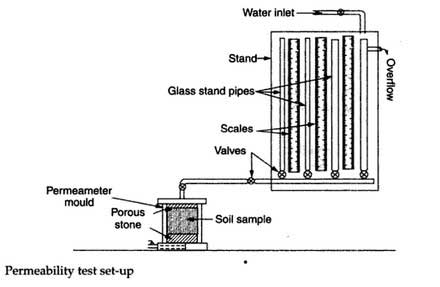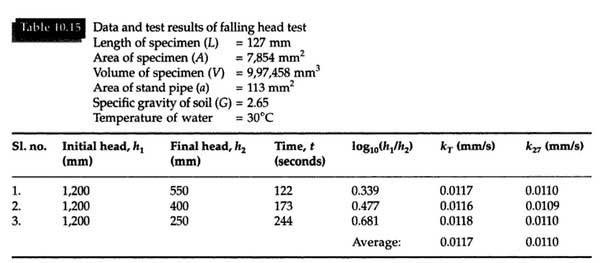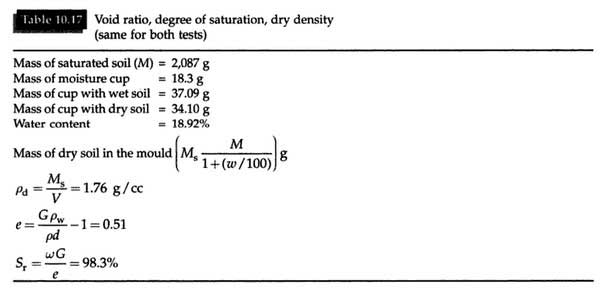So, Let’s Get Started.
Permeability Test of Soil.
Scope.
To determine the permeability of a given soil sample using a falling or constant head permeameter.
Apparatus.
1. Permeameter mold – of 1,000 ml capacity, 100 mm diameter, and 12.73 mm in height.
2. Compaction equipment – suitable dynamic or static compaction equipment.
3. Drainage base – with a porous disc of 12 mm thickness and dummy plate of 12 mm thickness to suit the mold, provided with water inlet/outlet connection.
4. Drainage cap – with a porous disc, 12 mm thick, and water inlet/outlet connection to the constant head tank.
5. Set of standpipes – glass standpipes of diameter 5 to 20 mm, suitably mounted on a stand (below Fig.).
6. Miscellaneous apparatus – IS sieves, mixing tray, graduated cylinder, metric scale, stopwatch, 75-gauge wire, thermometer, and source of water.
Procedure.
1. Take 2.5 kg of a sample (as suggested in the standard compaction test) and the desired water content
(may be field water content or optimum moisture content depending on the dry density requirement),
spread uniformly, and allow moisture equilibrium to be attained.
2. Weigh the empty permeameter.
Attach the extension collar, grease the inside of the mold and collar, and keep the assembly on a firm base.
3. Choose the type of compaction and compactive effort to suit the field condition, and complete the compaction process.
4. Remove the collar, level the soil, detach the base plate, and weigh.
5. Assemble the mold, drainage base, and cap along with porous discs (saturate the porous discs before use).
6. Saturate the specimen, by allowing water to flow with a sufficient head through it or by immersion for a high-permeability specimen;
and by subjecting it to a high head (for a day or two) for the permeable specimen.
(a) Falling head permeability test.
7. Connect the specimen through the top inlet to a selected standpipe of the inside area.
(a). Open the bottom outlet and note down the interval (t) required for the water level to fall from the initial head (h1) to a known final head (h2),
the heads being measured above the center of the outlet.
8. Fill the reservoir again to a higher h1 and note the time taken for the water level to fall to √h1.h2 and then to h2 again.
9. The time taken to fall from h1 to √h1.h2 and then from √h1.h2 to h2 should be the same.
Otherwise, repeat the test after re-filling the standpipe.
10. Report the test and take three observations.
(b) Constant head permeability test.
11. Connect the specimen through the top inlet to the constant headwater reservoir.
Open the bottom outlet and ascertain that the flow has attained a steady state.
12. Collect the quantity of flow for a convenient time interval (t) and repeat this for the same time interval thrice.
13. Find the mass of wet soil in the mold.
14. Keep samples for water content determination.
Computations.
The coefficient of permeability (k) for;
1. The falling head permeability test,
2. The constant head permeability test,
The permeability at 27°C is given as;
Results.
The coefficient of permeability is reported in mm/s or m/s at 27°C.
Typical test results are given in ##Tables 10.15 and 10.16 for falling and constant head permeabilities, respectively.
The void ratio, degree of saturation, and dry density are presented in ##Table 10.17.
Discussion.
Permeability tests can also be conducted on undisturbed specimens.
Prepare carefully a specimen 85 mm in diameter and 127 mm in height to suit the permeameter.
Place the specimen centrally over the porous disc and fill the annular gap with a cement slurry or bentonite sand mix in the ratio 1:9.
Fix the drainage cap.
Now a falling or constant head permeability test may be conducted, depending on the type of soil.
The constant head permeability test is usually preferred for sandy soils and the variable head permeability test for silty and clayey soils.
A separate constant head method for granular soils has been recommended by Indian Standards (IS: 2720 – Part 36, 1975).
This method is suitable for disturbed granular soils containing less than 10% soil passing 75 um IS sieve.
This range of particle sizes is used for the construction of embankments and base courses under pavements.
Granular soils with a particle size up to 20 mm can be tested using this method under laminar flow conditions.
Demerits of Permeability Test. (Laboratory).
Although these two laboratory methods are routinely used in various laboratories, they do not provide a reliable value for the following reasons:
1. A soil specimen in the laboratory is always disturbed to some extent and does not exist in the same state as in the field.
2. A laboratory specimen does not simulate the orientation of an in-situ-stratum to the flow of water.
3. Boundary conditions are not the same as simulated in the laboratory, e.g., smooth walls of the mold do not exist in the field.
4. There is a difference between the field and laboratory hydraulic gradients.
5. Complete saturation conditions are not possible in a laboratory sample, and the effect of entrapped air bubbles on the coefficient of permeability may be severe.
6. Prediction of the behavior of a large formation in-situ from the test results for a small sample is highly unreliable.
It is apparent that the laboratory determined k is not representative and is hence not reliable.
However, tests on undisturbed samples might improve this situation.
Read Also:
Consolidation Test of Soil; Its Scope, Apparatus, Procedure.
Unconfined Compression Test of Soil. [A Descriptive Guide].








pls help me with the formulas for falling head permeability.